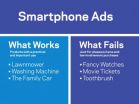(Press-News.org) NEW YORK — Brands spent $8.4 billion on mobile advertising in 2013, and that number is expected to quadruple to $36 billion by 2017, according to eMarketer. But do mobile display ads — those tiny banner ads that pop up in your smartphone's web browser — actually work? Researchers at Columbia Business School have found that, despite their size, mobile ads can have a big effect on consumers who are in the market for certain types of products.
"Digital advertising in mobile channels is experiencing explosive growth," said Miklos Sarvary, co-director of the Media Program at Columbia Business School and co-author of the new study. "But many marketers are still using a 'spray and pray' approach to digital ads. In other words, they're just putting mobile ads out there and hoping that they work. Limitations in tracking smartphone ads have always made it difficult for marketers to track and optimize their return on investment, but we've unlocked a part of that mystery now, which means they'll know how to best to spend their dollars."
The research, recently published in the Journal of Marketing Research, is titled "Which Products Are Best Suited to Mobile Advertising? A Field Study of Mobile Display Advertising Effects on Consumer Attitudes and Intentions," and co-authored by Andrew T. Stephen, assistant professor of Business Administration at Columbia Business School and Yakov Bart, assistant professor of Marketing at INSEAD.
Researchers found the below information:
Mobile ads do work for products that have a practical and important use, like a lawn mower or a washing machine
Mobile ads do work for high-involvement products (a lot of time, thought and energy is placed into the decision, like a family car).
Mobile ads don't work for just-for-pleasure items, like fancy watches
Mobile items don't work for low-involvement purchases like movie tickets or toothbrush (ones that pose a low risk to the buyer)
The Research
Sarvary and his fellow researchers looked specifically at the effects of mobile display ads (MDAs) viewed on a variety of mobile devices, including smartphones.
The researchers studied survey data from nearly 40,000 American consumers about their reactions to MDAs. The researchers focused on mobile display ads because, unlike text message ads or mobile video ads, the popularity of this mobile marketing tool is on the rise.
Over 50 products were represented in the ads, from consumer packaged goods and cars to financial services. After viewing an ad for one of these products on a mobile device, participants were asked to complete a survey that assessed their attitude toward and intention of buying the product.
To determine what kind of products are best-served by mobile display ads, the researchers classified each product as either "utilitarian" or "hedonic." In other words, does the product serve a useful purpose, like a washing machine or a lawnmower, or is it typically bought just for pleasure, like movie tickets or a fancy new watch?
Products were also classified as being either high or low involvement. Higher involvement products are those that people think a lot about before purchasing. For example, people tend to think quite a bit before purchasing a new minivan, but they don't think too hard before purchasing a low-involvement product, like a toothbrush.
The Results
What accounts for the results in the above? Sarvary believes it has something to do with psychology. Before making a big purchase, Sarvary explained, people tend to do a lot of rational thinking, comparing one product to another and weighing their options. And this rational thinking is magnified even more if the product being purchased isn't just a new big screen TV, but one that serves a more useful purpose, like a new family car.
It might take you weeks or months before deciding to bite the bullet and buy the car you've been thinking so much about, but as Sarvary explained, "During that time, you're debating with yourself about which model of car you should buy. If a display ad for that car shows up on your smartphone, even if it's tiny and doesn't provide you with new information, it'll reinforce what you already know about the product."
"The mobile ad's strength," Sarvary went on to say, "Is not adding new data, but reminding you of what you already know and making you think about the product again."
These findings carry huge implications for marketers who are planning a multi-channel campaign for a product, Sarvary said. Rather than sticking with a "spray and pray" approach, they might find it's more effective to launch mobile display ads after a product has been advertised in other media.
"That way," Sarvary said, "The banner ad seals the deal."
INFORMATION:
To learn more about the cutting-edge research being conducted at Columbia Business School, please visit http://www.gsb.columbia.edu.
About Columbia Business School
Columbia Business School is the only world–class, Ivy League business school that delivers a learning experience where academic excellence meets with real–time exposure to the pulse of global business. Led by Dean Glenn Hubbard, the School's transformative curriculum bridges academic theory with unparalleled exposure to real–world business practice, equipping students with an entrepreneurial mindset that allows them to recognize, capture, and create opportunity in any business environment. The thought leadership of the School's faculty and staff, combined with the accomplishments of its distinguished alumni and position in the center of global business, means that the School's efforts have an immediate, measurable impact on the forces shaping business every day. To learn more about Columbia Business School's position at the very center of business, please visit http://www.gsb.columbia.edu.
Smarter ads for smartphones: When they do and don't work
Study demystifies effectiveness of smartphone ads, offers marketers tips
2014-07-15
ELSE PRESS RELEASES FROM THIS DATE:
NASA sees Typhoon Rammasun's eye staring at Visayas, Philippines
2014-07-15
Early on July 15, Typhoon Rammasun began making landfall in the eastern part of the central Philippines and NASA's Aqua and TRMM satellites spotted the 20 nautical-mile-wide (23 mile/37 km) eye of the storm close to landfall.
Typhoon Rammasun was making landfall in the Visayas region. Visayas is located in the central Philippines.
The Tropical Rainfall Measuring Mission or TRMM satellite passed over Rammasun on Tuesday, July 15, 2014 at 04:10 UTC (12:10 a.m. EDT) and measured rainfall occurring throughout the storm. TRMM found moderate rainfall (about 35 mm)/1.4 inches ...
Scientists gear up to fight deadly snake fungal disease
2014-07-15
CHAMPAIGN, Ill. — Researchers have developed a faster and more accurate way to test for infection with Ophidiomyces ophiodiicola, a fungus that is killing snakes in the Midwest and eastern United States. The test also allows scientists to monitor the progression of the infection in living snakes.
The researchers reported on the test at the 2014 Mycological Society of America Annual Meeting.
"We need people to know that they don't have to anesthetize an animal to collect a biopsy sample or, worse yet, euthanize snakes in order to test for the infection," said University ...
This week from AGU: Dust models, Arctic Ocean waves, floods and climate change
2014-07-15
From AGU's blogs: Global climate models fail to simulate key dust characteristics
Climate models that simulate the airborne African dust that influences Atlantic Ocean hurricanes are not up to the task of accurately representing the characteristics of that dust, according to a new study accepted for publication in Geophysical Research Letters.
From AGU's journals: Surface waves contribute to ice retreat in Beaufort Sea
Surface waves, created by blowing wind, play a role in energy and nutrient transport and also shape coasts through erosion. Because the Arctic Ocean ...
New UK study helps scientists understand melanoma development
2014-07-15
LEXINGTON, Ky. (July 15, 2014) — A new study by University of Kentucky researchers shows how a genetic defect in a specific hormonal pathway may make people more susceptible to developing melanoma, the deadliest type of skin cancer.
Fair-skinned people who tend to burn (rather than tan) from sun exposure have a much higher risk for melanoma than darker-skinned people. On the surface, it appears that the amount of melanin, the natural substance in the skin that determines pigment and acts as the skin's "natural sunscreen," would be the only determinant of melanoma risk. ...
Directly visualizing hydrogen bonds
2014-07-15
WASHINGTON D.C., July 15, 2014 – Using a newly developed, ultrafast femtosecond infrared light source, chemists at the University of Chicago have been able to directly visualize the coordinated vibrations between hydrogen-bonded molecules -- the first time this sort of chemical interaction, which is found in nature everywhere at the molecular level, has been directly visualized. They describe their experimental techniques and observations in The Journal of Chemical Physics, from AIP Publishing.
"These two-dimensional infrared spectroscopy techniques provide a new avenue ...
New feathered predatory fossil sheds light on dinosaur flight
2014-07-15
LOS ANGELES—A new raptorial dinosaur fossil with exceptionally long feathers has provided exciting insights into dinosaur flight. A paper published in Nature Communications on July 15, 2014 asserts that the fossil—discovered by an international team led by Natural History Museum of Los Angeles County (NHM) paleontologist Dr. Luis Chiappe—has a long feathered tail that Chiappe and co-authors believe was instrumental for decreasing descent speed and assuring safe landings.
The 125-million-year-old dinosaur, named Changyuraptor yangi, was found in the Liaoning Province ...
New materials for future green tech devices
2014-07-15
WASHINGTON D.C., July 15, 2014 -- From your hot car to your warm laptop, every machine and device in your life wastes a lot of energy through the loss of heat. But thermoelectric devices, which convert heat to electricity and vice versa, can harness that wasted heat, and possibly provide the green tech energy efficiency that's needed for a sustainable future.
Now, a new study shows how porous substances can act as thermoelectric materials—pointing the way for engineering the use of such materials in thermoelectric devices of the future.
About 70 percent of all the energy ...
Widespread support for rapid HIV testing in dental surgeries -- new study
2014-07-15
More than 80 per cent of oral health patients are willing to receive rapid HIV-testing in dental settings, which could help reduce the spread of the HIV according to a groundbreaking study revealed today at a Sydney University HIV Testing Symposium.
The first of its kind study of 521 Sydney-based dental patients assessed patients' willingness to undergo rapid HIV testing in dental settings, their preference for HIV testing-type type and their willingness to pay for the test.
Rapid HIV testing is a screening test that swiftly detects the presence of HIV antibodies in ...
Hear Jane read: Rutgers University-Newark researcher gives new meaning to semantics
2014-07-15
For years a key way of diagnosing dyslexia has been how well a person reads aloud. Similarly, the reading skills of adult readers also have been assessed by having them read words aloud. "The idea is that the more you read in English, the more you will encounter words that don't follow standard rules of pronunciation, so it's an index of reading exposure and, presumably, ability," explains researcher William W. Graves. But are you a better reader if you pronounce a word based on its meaning, or based on its spelling? Does it make a difference? And why? Those are the ...
Genetic testing for alcohol dependence risk in African Americans
2014-07-15
New Rochelle, NY, July 15, 2014—Alcohol dependence (AD) has a genetic component and testing can determine a person's genetic risk for susceptibility to AD. A new study shows that while more than 85% of the African American adults expressed an interest in genetic testing for AD susceptibility, many had ethical, privacy, and procedural concerns, as reported in Genetic Testing and Molecular Biomarkers, a peer-reviewed journal from Mary Ann Liebert, Inc., publishers. The article is available on the Genetic Testing and Molecular Biomarkers website.
Denise Scott and coauthors ...
LAST 30 PRESS RELEASES:
Securing AI systems against growing cybersecurity threats
Longest observation of an active solar region
Why nail-biting, procrastination and other self-sabotaging behaviors are rooted in survival instincts
Regional variations in mechanical properties of porcine leptomeninges
Artificial empathy in therapy and healthcare: advancements in interpersonal interaction technologies
Why some brains switch gears more efficiently than others
UVA’s Jundong Li wins ICDM’S 2025 Tao Li Award for data mining, machine learning
UVA’s low-power, high-performance computer power player Mircea Stan earns National Academy of Inventors fellowship
Not playing by the rules: USU researcher explores filamentous algae dynamics in rivers
Do our body clocks influence our risk of dementia?
Anthropologists offer new evidence of bipedalism in long-debated fossil discovery
Safer receipt paper from wood
Dosage-sensitive genes suggest no whole-genome duplications in ancestral angiosperm
First ancient human herpesvirus genomes document their deep history with humans
Why Some Bacteria Survive Antibiotics and How to Stop Them - New study reveals that bacteria can survive antibiotic treatment through two fundamentally different “shutdown modes”
UCLA study links scar healing to dangerous placenta condition
CHANGE-seq-BE finds off-target changes in the genome from base editors
The Journal of Nuclear Medicine Ahead-of-Print Tip Sheet: January 2, 2026
Delayed or absent first dose of measles, mumps, and rubella vaccination
Trends in US preterm birth rates by household income and race and ethnicity
Study identifies potential biomarker linked to progression and brain inflammation in multiple sclerosis
Many mothers in Norway do not show up for postnatal check-ups
Researchers want to find out why quick clay is so unstable
Superradiant spins show teamwork at the quantum scale
Cleveland Clinic Research links tumor bacteria to immunotherapy resistance in head and neck cancer
First Editorial of 2026: Resisting AI slop
Joint ground- and space-based observations reveal Saturn-mass rogue planet
Inheritable genetic variant offers protection against blood cancer risk and progression
Pigs settled Pacific islands alongside early human voyagers
A Coral reef’s daily pulse reshapes microbes in surrounding waters
[Press-News.org] Smarter ads for smartphones: When they do and don't workStudy demystifies effectiveness of smartphone ads, offers marketers tips






